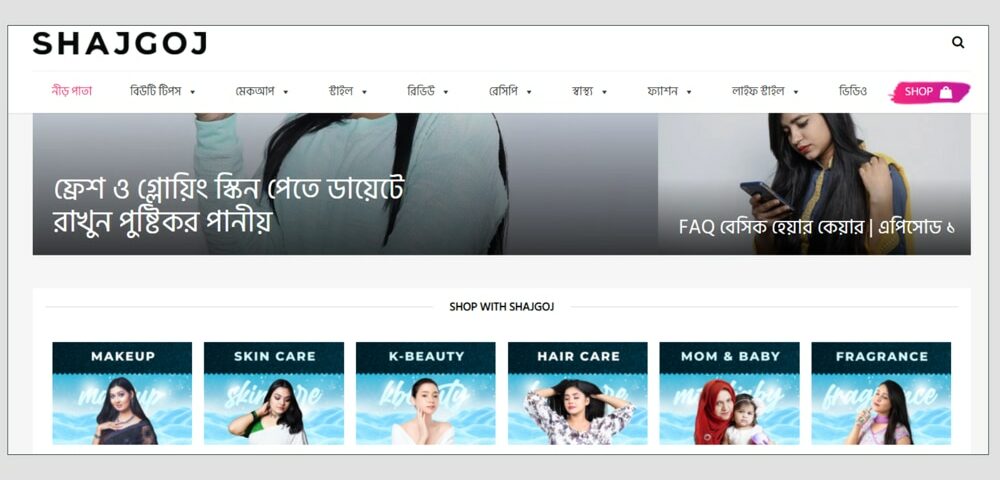
Shajgoj, Dhaka-based beauty and personal care startup, announced on December 25th that it has raised $2 million in seed funding led by Sequoia Capital India’s Surge and participated by Dhaka-based tech-focused venture capital fund SBK Tech Venture.
Shajgoj is one of the 20 startups that have been selected for Sequoia India’s latest cohort of Surge accelerator program. Shajgoj is one of the two startups from Bangladesh in this year’s program. The other startup is edtech company 10 Minute School. Sequoia India previously invested in Bangladeshi B2B commerce startup Shopup.
Previously, Shajgoj raised investment from Brac Osiris Impact Ventures, Ahan Investment, and Singapore-based Angel investor.
Shajgoj runs a beauty and personal care-focused omnichannel ecommerce business. The company uses a content and commerce-focused model where it produces and uses beauty and personal care content to generate interest and sales. The company also runs two offline outlets in Dhaka. With the fresh funding, Shajgoj plans to “acquire more customers, open new outlets and offer more international brands on its platform.”
Founded in 2013 by Milky Mahmud, Nazmul Sheik, and Sinthia Islam, Shajgoj is the first Bangladeshi ecommerce company to try content, commerce, and community trifacta.
There is a huge dearth of Bangla language authentic information on beauty, skincare, and personal care. In many instances, authentic product information is a challenge. As a result, counterfeit beauty products have become a real challenge in the market.
Shajgoj has taken that market dynamics as an opportunity and started investing in producing useful video content on beauty and skincare. The move has helped the company quickly build an audience, build trust and build a community around content that it has successfully capitalized to build a beauty products business.
Shajgo today sells authentic products at reasonable prices from renowned brands and local distributors through their physical stores and online platforms. The company claims it currently delivers 180,000 orders monthly and sells over 10,000 different products from over 400 renowned brands to over 350,000 customers.
There are several advantages to using a content, community and commerce model in ecommerce. While it is a difficult recipe to pull off, there are examples of companies that have successfully used the model to build category dominant businesses.
The upsides of such a model come from the power of content to help build community. The hypothesis is simple: if you offer useful content, it will help you to attract users aka readers. If the users and readers trust your content, they will be happy to shop on your platform if you have such an option. And if you gradually allow your users to interact within your platform and outside, you are set for building a community.
Beauty and personal care are critical for women. It means they seek out content and advice on beauty and personal care. Moreover, if they find a community around beauty and personal care that they can trust, it is a no-brainer.
Thus Shajgoj’s flywheel looks something like this: produce high-quality content on beauty and personal care > distribute the content well and bring more traffic to the website > allow customers to shop on your platform and deliver authentic products at reasonable prices with excellent service > build loyalty and customer interaction > deliver even better content and shopping experience and keep the flywheel moving.
Of course, there are nuances to this narrative that will arise in execution. Content production is expensive. Producing content that attracts an audience and helps gain trust is hard. Moreover, the internet is littered with beauty and personal care content. It is a highly competitive domain. You have to create high-quality content to beat the competition and build an audience. Similarly, building a community is not easy. It takes a lot of effort and investment. Adding commerce with a community is always risky because a community is about trust and commerce is about transaction. They operate from opposing values.
The strategy makes a lot of sense if one can execute with a long-term view. There are examples of successful companies in the space across verticals. For example, Food52 in food and culinary products retail and Houzz in home remodeling and design. In India, MyGlamm has built a beauty commerce business similar to Shajgoj at the intersection of content-community-commerce. The company not only creates beauty content, but it also allows users to create content on its platform.
Shajgoj has built a sizable business and an effective growth flywheel around content. Using its offline retail operation, it can use the power to build an offline community as well. Being a women-focused brand allows Shajgoj even more power to create a community based on common interests.
Shajgoj claims to be one of the largest ecommerce players in Dhaka and probably the largest beauty and personal care DTC brand. Given its trajectory today, the company can become the most dominant DTC player in the beauty and personal care category in Dhaka.
On top of that, Shajgoj operates in a fascinating market. Beauty and personal care is a fast-growing market in Bangladesh. The FMCG market is estimated to be an over BDT 30,000 crore market with an excellent annual growth rate. Penetration and per capita consumption offer a huge market opportunity for companies in personal care categories.
However, scaling from here to the next level will not come easily for Shajgoj. As I mentioned earlier, content production is expensive and building community does not get any easier. How Shajgoj navigates the balance will determine its next round of growth.
